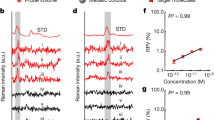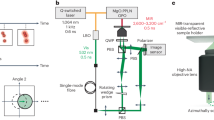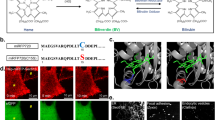Abstract
When under stress, plants release molecules to activate their defense system. Detecting these stress-related molecules offers the possibility to address stress conditions and prevent the development of diseases. However, detecting endogenous signalling molecules in living plants remains challenging due to low concentrations of these analytes and interference with other compounds; additionally, many methods currently used are invasive and labour-intensive. Here we show a non-destructive surface-enhanced Raman scattering (SERS)-based nanoprobe for the real-time detection of multiple stress-related endogenous molecules in living plants. The nanoprobe, which is placed in the intercellular space, is optically active in the near-infrared region (785 nm) to avoid interferences from plant autofluorescence. It consists of a Si nanosphere surrounded by a corrugated Ag shell modified by a water-soluble cationic polymer poly(diallyldimethylammonium chloride), which can interact with multiple plant signalling molecules. We measure a SERS enhancement factor of 2.9 × 107 and a signal-to-noise ratio of up to 64 with an acquisition time of ~100 ms. To show quantitative multiplex detection, we adopted a binding model to interpret the SERS intensities of two different analytes bound to the SERS hot spot of the nanoprobe. Under either abiotic or biotic stress, our optical nanosensors can successfully monitor salicylic acid, extracellular adenosine triphosphate, cruciferous phytoalexin and glutathione in Nasturtium officinale, Triticum aestivum L. and Hordeum vulgare L.—all stress-related molecules indicating the possible onset of a plant disease. We believe that plasmonic nanosensor platforms can enable the early diagnosis of stress, contributing to a timely disease management of plants.
This is a preview of subscription content, access via your institution
Access options
Access Nature and 54 other Nature Portfolio journals
Get Nature+, our best-value online-access subscription
$29.99 / 30 days
cancel any time
Subscribe to this journal
Receive 12 print issues and online access
$259.00 per year
only $21.58 per issue
Buy this article
- Purchase on Springer Link
- Instant access to full article PDF
Prices may be subject to local taxes which are calculated during checkout






Similar content being viewed by others
Data availability
The data that support the findings of this study are available within the Article and Supplementary Information. Raw data of the results reported in this study are available via figshare at https://figshare.com/articles/dataset/In_vivo_SERS_nanosensor_for_plant_signaling_molecules/21316554. All other relevant data and findings of this study are available from the corresponding authors upon reasonable request. Source data are provided with this paper.
References
Durrant, W. E. & Dong, X. Systemic acquired resistance. Annu. Rev. Phytopathol. 42, 185–209 (2004).
Koornneef, A. & Pieterse, C. M. Cross talk in defense signaling. Plant Physiol. 146, 839–844 (2008).
Pieterse, C. M., Leon-Reyes, A., Van der Ent, S., Van & Wees, S. C. Networking by small-molecule hormones in plant immunity. Nat. Chem. Biol. 5, 308–316 (2009).
Gaffney, T. et al. Requirement of salicylic acid for the induction of systemic acquired resistance. Science 261, 754–756 (1993).
Lim, G. H. et al. The plant cuticle regulates apoplastic transport of salicylic acid during systemic acquired resistance. Sci. Adv. 6, eaaz0478 (2020).
Chivasa, S. et al. Extracellular ATP is a regulator of pathogen defence in plants. Plant J. 60, 436–448 (2009).
Song, C. J., Steinebrunner, I., Wang, X., Stout, S. C. & Roux, S. J. Extracellular ATP induces the accumulation of superoxide via NADPH oxidases in Arabidopsis. Plant Physiol. 140, 1222–1232 (2006).
Pedras, M. S., Okanga, F. I., Zaharia, I. L. & Khan, A. Q. Phytoalexins from crucifers: synthesis, biosynthesis, and biotransformation. Phytochemistry 53, 161–176 (2000).
Kocsy, G., Galiba, G. & Brunold, C. Role of glutathione in adaptation and signalling during chilling and cold acclimation in plants. Physiol. Plant. 113, 158–164 (2001).
Noctor, G. et al. Glutathione in plants: an integrated overview. Plant Cell Environ. 35, 454–484 (2012).
Zhu, J.-K. Abiotic stress signaling and responses in plants. Cell 167, 313–324 (2016).
Toyota, M. et al. Glutamate triggers long-distance, calcium-based plant defense signaling. Science 361, 1112–1115 (2018).
Berens, M. L. et al. Balancing trade-offs between biotic and abiotic stress responses through leaf age-dependent variation in stress hormone cross-talk. Proc. Natl Acad. Sci. USA 116, 2364–2373 (2019).
Lew, T. T. S. et al. Species-independent analytical tools for next-generation agriculture. Nat. Plants 6, 1408–1417 (2020).
Wu, H. et al. Monitoring plant health with near-infrared fluorescent H2O2 nanosensors. Nano Lett. 20, 2432–2442 (2020).
Lew, T. T. S., Park, M., Cui, J. & Strano, M. S. Plant nanobionic sensors for arsenic detection. Adv. Mater. 33, 2005683 (2021).
Ang, M. C.-Y. et al. Nanosensor detection of synthetic auxins in planta using corona phase molecular recognition. ACS Sens. 6, 3032–3046 (2021).
Lew, T. T. S. et al. Real-time detection of wound-induced H2O2 signalling waves in plants with optical nanosensors. Nat. Plants 6, 404–415 (2020).
Logan, N. et al. Handheld SERS coupled with QuEChERs for the sensitive analysis of multiple pesticides in basmati rice. npj Sci. Food 6, 3 (2022).
Han, D., Yao, J., Quan, Y., Gao, M. & Yang, J. Plasmon-coupled charge transfer in FSZA core-shell microspheres with high SERS activity and pesticide detection. Sci. Rep. 9, 13876 (2019).
Wang, T. et al. Emerging core–shell nanostructures for surface-enhanced Raman scattering (SERS) detection of pesticide residues. Chem. Eng. J. 424, 130323 (2021).
Sun, Y. et al. Simultaneous SERS detection of illegal food additives rhodamine B and basic orange II based on Au nanorod-incorporated melamine foam. Food Chem. 357, 129741 (2021).
Wang, C. M., Roy, P. K., Juluri, B. K. & Chattopadhyay, S. A. SERS tattoo for in situ, ex situ, and multiplexed detection of toxic food additives. Sens. Actuators B 261, 218–225 (2018).
Hassan, M. M., Zareef, M., Xu, Y., Li, H. & Chen, Q. SERS based sensor for mycotoxins detection: challenges and improvements. Food Chem. 344, 128652 (2021).
Li, J., Yan, H., Tan, X., Lu, Z. & Han, H. Cauliflower-inspired 3D SERS substrate for multiple mycotoxins detection. Anal. Chem. 91, 3885–3892 (2019).
Kim, S. et al. Feasibility study for detection of turnip yellow mosaic virus (TYMV) infection of Chinese cabbage plants using Raman spectroscopy. Plant Pathol. J. 29, 105–109 (2013).
Lin, Y.-J., Lin, H.-K. & Lin, Y.-H. Construction of Raman spectroscopic fingerprints for the detection of Fusarium wilt of banana in Taiwan. PLoS ONE 15, e0230330 (2020).
Zhang, Y. et al. Ultrasensitive detection of plant hormone abscisic acid-based surface-enhanced Raman spectroscopy aptamer sensor. Anal. Bioanal. Chem. 414, 2757–2766 (2022).
David, M., Serban, A., Radulescu, C., Danet, A. F. & Florescu, M. Bioelectrochemical evaluation of plant extracts and gold nanozyme-based sensors for total antioxidant capacity determination. Bioelectrochemistry 129, 124–134 (2019).
Gupta, S. et al. Portable Raman leaf-clip sensor for rapid detection of plant stress. Sci. Rep. 10, 20206 (2020).
Huang, C. H. et al. Early diagnosis and management of nitrogen deficiency in plants utilizing Raman spectroscopy. Front. Plant Sci. 11, 663 (2020).
Altangerel, N. et al. In vivo diagnostics of early abiotic plant stress response via Raman spectroscopy. Proc. Natl Acad. Sci. USA 114, 3393–3396 (2017).
Chen, H., Wang, Y. & Dong, S. An effective hydrothermal route for the synthesis of multiple PDDA-protected noble-metal nanostructures. Inorg. Chem. 46, 10587–10593 (2007).
Vaia, R. A. & Giannelis, E. P. Polymer melt intercalation in organically-modified layered silicates: model predictions and experiment. Macromolecules 30, 8000–8009 (1997).
Tanaka, K., Gilroy, S., Jones, A. M. & Stacey, G. Extracellular ATP signaling in plants. Trends Cell Biol. 20, 601–608 (2010).
Kim, S. Y., Sivaguru, M. & Stacey, G. Extracellular ATP in plants. Visualization, localization, and analysis of physiological significance in growth and signaling. Plant Physiol. 142, 984–992 (2006).
Lv, W. et al. Multi-hydrogen bond assisted SERS detection of adenine based on multifunctional graphene oxide/poly (diallyldimethyl ammonium chloride)/Ag nanocomposites. Talanta 204, 372–378 (2019).
Dutta, J., Sahu, A. K., Bhadauria, A. S. & Biswal, H. S. Carbon-centered hydrogen bonds in proteins. J. Chem. Inf. Model. 62, 1998–2008 (2022).
Copeland, K. L. & Tschumper, G. S. Hydrocarbon/water interactions: encouraging energetics and structures from DFT but disconcerting discrepancies for Hessian indices. J. Chem. Theory Comput. 8, 1646–1656 (2012).
Dark, A., Demidchik, V., Richards, S. L., Shabala, S. & Davies, J. M. Release of extracellular purines from plant roots and effect on ion fluxes. Plant Signal. Behav. 6, 1855–1857 (2011).
Tálas, E. et al. Surface enhanced Raman spectroscopic (SERS) behavior of phenylpyruvates used in heterogeneous catalytic asymmetric cascade reaction. Spectrochim. Acta A Mol. Biomol. Spectrosc. 260, 119912 (2021).
Lew, T. T. S. et al. Rational design principles for the transport and subcellular distribution of nanomaterials into plant protoplasts. Small 14, e1802086 (2018).
Kwak, S.-Y. et al. A nanobionic light-emitting plant. Nano Lett. 17, 7951–7961 (2017).
Teale, W. D., Paponov, I. A. & Palme, K. Auxin in action: signalling, transport and the control of plant growth and development. Nat. Rev. Mol. Cell Biol. 7, 847–859 (2006).
Wittek, F. et al. Folic acid induces salicylic acid-dependent immunity in Arabidopsis and enhances susceptibility to Alternaria brassicicola. Mol. Plant Pathol. 16, 616–622 (2015).
Chen, T. T., Kuo, C. S., Chou, Y. C. & Liang, N. T. Surface-enhanced Raman scattering of adenosine triphosphate molecules. Langmuir 5, 887–891 (1989).
Chadha, R., Das, A., Kapoor, S. & Maiti, N. Surface-induced dimerization of 2-thiazoline-2-thiol on silver and gold nanoparticles: a surface enhanced Raman scattering (SERS) and density functional theoretical (DFT) study. J. Mol. Liq. 322, 114536 (2021).
Pedras, M. S. C. & To, Q. H. Interrogation of biosynthetic pathways of the cruciferous phytoalexins nasturlexins with isotopically labelled compounds. Org. Biomol. Chem. 16, 3625–3638 (2018).
Herschbach, C. & Rennenberg, H. Influence of glutathione (GSH) on net uptake of sulphate and sulphate transport in tobacco plants. J. Exp. Bot. 45, 1069–1076 (1994).
Vanacker, H., Carver, T. L. & Foyer, C. H. Pathogen-induced changes in the antioxidant status of the apoplast in barley leaves. Plant Physiol. 117, 1103–1114 (1998).
Kuligowski, J. et al. Surface enhanced Raman spectroscopic direct determination of low molecular weight biothiols in umbilical cord whole blood. Analyst 141, 2165–2174 (2016).
Hao, Q. et al. Isochorismate-based salicylic acid biosynthesis confers basal resistance to Fusarium graminearum in barley. Mol. Plant Pathol. 19, 1995–2010 (2018).
Goswami, R. S. & Kistler, H. C. Heading for disaster: Fusarium graminearum on cereal crops. Mol. Plant Pathol. 5, 515–525 (2004).
Feng, H. et al. Extracellular ATP is involved in the salicylic acid-induced cell death in suspension-cultured tobacco cells. Plant Prod. Sci. 18, 154–160 (2015).
Lefevere, H., Bauters, L. & Gheysen, G. Salicylic acid biosynthesis in plants. Front. Plant Sci. 11, 338 (2020).
Ding, L. et al. Resistance to hemi-biotrophic F. graminearum infection is associated with coordinated and ordered expression of diverse defense signaling pathways. PLoS ONE 6, e19008 (2011).
Fu, Z. Q. & Dong, X. Systemic acquired resistance: turning local infection into global defense. Annu Rev. Plant Biol. 64, 839–863 (2013).
Rico, A., Bennett, M. H., Forcat, S., Huang, W. E. & Preston, G. M. Agroinfiltration reduces ABA levels and suppresses Pseudomonas syringae-elicited salicylic acid production in Nicotiana tabacum. PLoS ONE 5, e8977 (2010).
Tsuji, J., Jackson, E. P., Gage, D. A., Hammerschmidt, R. & Somerville, S. C. Phytoalexin accumulation in Arabidopsis thaliana during the hypersensitive reaction to Pseudomonas syringae pv syringae. Plant Physiol. 98, 1304–1309 (1992).
Cha, M. G. et al. Effect of alkylamines on morphology control of silver nanoshells for highly enhanced Raman scattering. ACS Appl. Mater. Interfaces 11, 8374–8381 (2019).
Leslie, J. F. & Summerell, B. A. Fusarium laboratory workshops—a recent history. Mycotoxin Res. 22, 73–74 (2006).
Sarowar, S. et al. Targeting the pattern-triggered immunity pathway to enhance resistance to Fusarium graminearum. Mol. Plant Pathol. 20, 626–640 (2019).
Taylor, S. C. et al. The ultimate qPCR experiment: producing publication quality, reproducible data the first time. Trends Biotechnol. 37, 761–774 (2019).
Gao, J. et al. WRKY transcription factors associated with NPR1-mediated acquired resistance in barley are potential resources to improve wheat resistance to Puccinia triticina. Front. Plant Sci. 9, 1486 (2018).
Manghwar, H. et al. Disease severity, resistance analysis, and expression profiling of pathogenesis-related protein genes after the inoculation of Fusarium equiseti in wheat. Agronomy 11, 2124 (2021).
Acknowledgements
This research was supported by Korea Institute of Planning and Evaluation for Technology in Food, Agriculture, Forestry and Fisheries (IPET) through Crop Viruses and Pests Response Industry Technology Development Program, funded by the Ministry of Agriculture, Food and Rural Affairs (MAFRA) (no. 321107-03), the National Research Foundation of Korea (NRF) grant funded by the Korean government (the Ministry of Science and ICT) (nos. 2021R1C1C1005691, 2020R1A4A1018017 and 2021R1A4A5031762) and the Creative-Pioneering Researchers Program through Seoul National University. We are grateful for the helpful discussion with Y.-S. Lee.
Author information
Authors and Affiliations
Contributions
S.-Y.K. and D.H.J. conceived the experiments and obtained funding for—and oversaw—the research. W.K.S., Y.S.C. and D.W.S. synthesized and characterized the nanoparticles and performed the sensing experiments. Y.W.H. and M.J.L. assisted with the experiments. K.M., J.S. and H.S. prepared the plant disease models. W.K.S., S.-Y.K. and D.H.J. analysed the data. W.K.S. and S.-Y.K. wrote the initial manuscript, which was edited by S.-Y.K. and D.H.J.
Corresponding authors
Ethics declarations
Competing interests
The authors declare no competing interests.
Peer review
Peer review information
Nature Nanotechnology thanks Bin Ren, Sebastian Schluecker and the other, anonymous, reviewer(s) for their contribution to the peer review of this work.
Additional information
Publisher’s note Springer Nature remains neutral with regard to jurisdictional claims in published maps and institutional affiliations.
Supplementary information
Supplementary Information
Supplementary Notes 1–18, Figs. 1–28, Equations (1)–(18) and Tables 1–4.
Source data
Source Data Fig. 1
SERS spectrum and statistical source.
Source Data Fig. 2
SERS spectrum and false image matrix.
Source Data Fig. 3
SERS spectrum and curve fitting data.
Source Data Fig. 4
SERS spectrum and statistical source.
Source Data Fig. 5
SERS spectrum and statistical source.
Source Data Fig. 6
Statistical source.
Rights and permissions
Springer Nature or its licensor (e.g. a society or other partner) holds exclusive rights to this article under a publishing agreement with the author(s) or other rightsholder(s); author self-archiving of the accepted manuscript version of this article is solely governed by the terms of such publishing agreement and applicable law.
About this article
Cite this article
Son, W.K., Choi, Y.S., Han, Y.W. et al. In vivo surface-enhanced Raman scattering nanosensor for the real-time monitoring of multiple stress signalling molecules in plants. Nat. Nanotechnol. 18, 205–216 (2023). https://doi.org/10.1038/s41565-022-01274-2
Received:
Accepted:
Published:
Issue Date:
DOI: https://doi.org/10.1038/s41565-022-01274-2
This article is cited by
-
Lighting up plants with near-infrared fluorescence probes
Science China Chemistry (2024)
-
Nanosensors for monitoring plant health
Nature Nanotechnology (2023)



